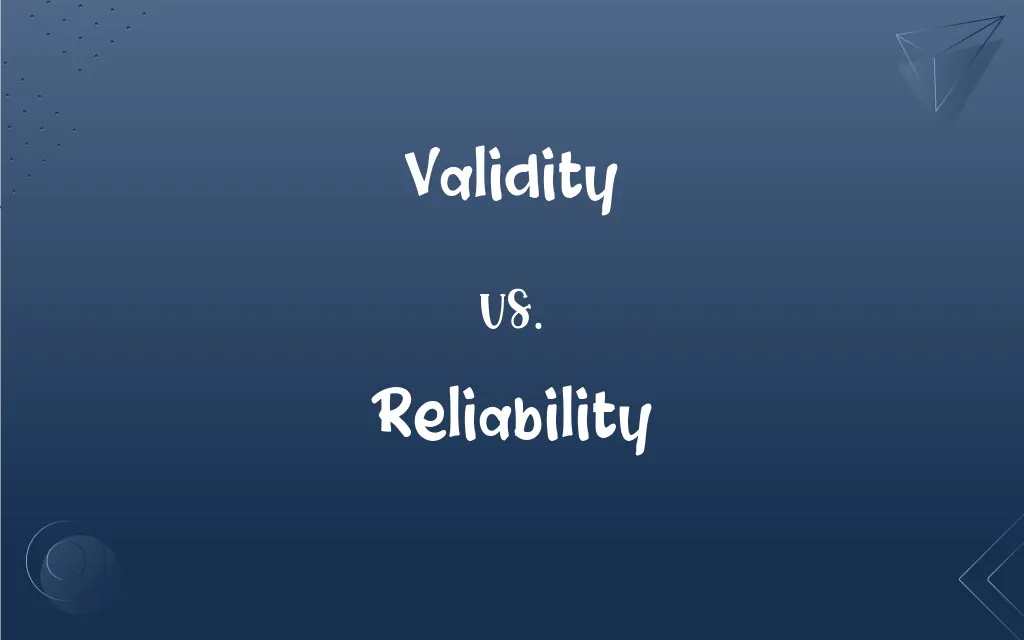Validity vs. Reliability: What's the Difference?
Edited by Aimie Carlson || By Harlon Moss || Updated on October 10, 2023
Validity refers to how well a test measures what it's intended to, while reliability pertains to the consistency of test results over time.

Key Differences
Validity is a crucial aspect of assessment and research, determining how accurately a test or tool measures the concept it claims to evaluate. On the other hand, reliability is about the stability and consistency of these measurements. If a method produces different results under the same conditions, its reliability is questioned.
Validity ensures that the instrument, test, or method is suitable for its intended purpose. Without validity, results might not be meaningful or relevant. Conversely, reliability ensures that this tool produces stable and consistent results. A test might be valid, accurately measuring a concept, but if it's not reliable, its results can't be trusted over repeated uses.
When aiming for high validity, researchers or practitioners are essentially asking: "Are we measuring the right thing?" In contrast, when ensuring reliability, the question is: "Is our measurement consistent?" It's possible for a test to be reliable, consistently giving the same result, but not valid, meaning it doesn't measure the intended concept correctly.
In practical terms, validity might involve ensuring that a math test evaluates math skills and not reading ability. Reliability, however, would mean that this math test gives consistent scores when taken multiple times by the same student, assuming their skills remain constant.
Lastly, while both validity and reliability are vital, they serve different purposes. Having a reliable tool is of little value if it's not valid. Simultaneously, a valid tool is undermined if its results aren't consistent, highlighting the interconnected importance of both concepts.
ADVERTISEMENT
Comparison Chart
Definition
How well a test measures its intended concept
Consistency of results over repeated measures
Key Question
Are we measuring the right thing?
Is our measurement consistent?
Possible Issue
Measures an unintended concept
Inconsistent results over time
Example Focus
A math test evaluating math skills
A math test giving stable scores over time
Interrelation
Can exist without reliability
Can exist without validity
ADVERTISEMENT
Validity and Reliability Definitions
Validity
Validity ensures results are meaningful and relevant.
The validity of the study's findings was supported by the data collected.
Reliability
It pertains to the stability of measurements.
Given the reliability of the thermometer, we trusted its readings.
Validity
It considers whether the method is appropriate for its purpose.
The validity of the survey was questioned because it seemed to assess attitudes rather than knowledge.
Reliability
Reliability ensures the tool's results can be trusted.
We chose that method due to its proven reliability in past research.
Validity
It determines if the test measures the intended concept.
To establish the validity of the exam, we ensured it assessed math skills.
Reliability
It examines whether outcomes are reproducible.
The test's reliability was evident, as students got similar scores upon retaking it.
Validity
Validity asks if the right thing is being measured.
The test's validity was in doubt as it seemed more focused on reading than arithmetic.
Reliability
Reliability seeks consistent outcomes in the same conditions.
The instrument's reliability was affirmed by its stable output in controlled settings.
Validity
Validity refers to the accuracy of measurement.
The validity of the questionnaire was confirmed by experts in the field.
Reliability
Reliability is about consistent results over time.
The reliability of the scale was demonstrated through repeated weigh-ins.
FAQs
Can you define validity in simple terms?
Validity pertains to how accurately a method captures the variable it purports to measure.
How is concurrent validity determined?
Concurrent validity is determined by correlating a test's scores with an established criterion measure taken at the same time.
How does parallel-forms reliability ensure consistency?
Parallel-forms reliability involves assessing the consistency between two different forms of a test, ensuring equivalent measurement.
How would you explain reliability to a layperson?
Reliability implies the ability of a measure to produce consistent and stable results when repeated.
Can validity impact the outcomes of an experiment?
Yes, validity is crucial as it influences the accuracy of the conclusions drawn from experimental results.
How can low reliability affect research findings?
Low reliability can introduce error and inconsistency, thus jeopardizing the trustworthiness of research findings.
Can a reliable test be considered automatically valid?
No, a reliable test isn’t automatically valid as it might be consistently measuring the wrong variable.
Can a measure be reliable for some populations and not others?
Yes, reliability can differ across populations due to various factors like cultural nuances or linguistic variations.
How is face validity evaluated?
Face validity is often evaluated informally, considering whether, on the face of it, a measure appears to gauge the intended construct.
What role does predictive validity play in test development?
Predictive validity assesses how well a test predicts future behaviors or outcomes pertinent to the construct.
What is convergent validity in measurement?
Convergent validity reflects how closely the measure is related to other variables or measures with which it theoretically should correlate.
Why is split-half reliability used?
Split-half reliability, assessing the internal consistency of a test, is used to estimate whether all parts of a test are measuring the same construct.
Is validity concerned with consistency?
Not primarily; validity focuses on accuracy, although it does require some degree of consistency to establish sound results.
How is reliability established in qualitative research?
In qualitative research, reliability might be established through techniques like coder training or member checking to ensure consistent findings.
Is internal consistency related to reliability?
Yes, internal consistency, often measured by Cronbach’s alpha, assesses reliability by examining the coherence among multiple items.
Does test-retest measure reliability or validity?
Test-retest measures reliability by assessing the stability of scores over time.
How does ecological validity differ from internal validity?
While ecological validity concerns how findings generalize to real-world scenarios, internal validity focuses on the accuracy of conclusions within the research context.
What is external validity concerned with?
External validity concerns the generalizability of research findings beyond the specific sample or context studied.
Can reliability coefficients range above 1?
No, reliability coefficients typically range from 0 (no reliability) to 1 (perfect reliability).
Is divergent validity opposite to convergent validity?
Yes, divergent validity assesses whether a measure does not correlate with unrelated variables, contrary to convergent validity.
About Author
Written by
Harlon MossHarlon is a seasoned quality moderator and accomplished content writer for Difference Wiki. An alumnus of the prestigious University of California, he earned his degree in Computer Science. Leveraging his academic background, Harlon brings a meticulous and informed perspective to his work, ensuring content accuracy and excellence.
Edited by
Aimie CarlsonAimie Carlson, holding a master's degree in English literature, is a fervent English language enthusiast. She lends her writing talents to Difference Wiki, a prominent website that specializes in comparisons, offering readers insightful analyses that both captivate and inform.































































